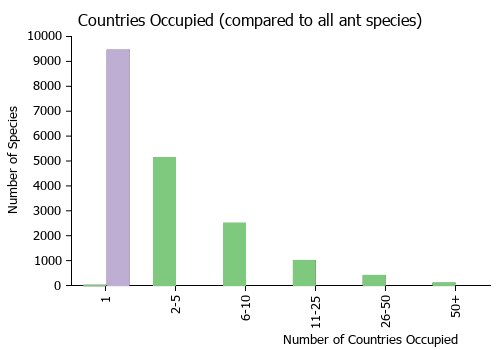Epopostruma mercurii
| Epopostruma mercurii | |
|---|---|

| |
| Scientific classification | |
| Kingdom: | Animalia |
| Phylum: | Arthropoda |
| Class: | Insecta |
| Order: | Hymenoptera |
| Family: | Formicidae |
| Subfamily: | Myrmicinae |
| Tribe: | Attini |
| Genus: | Epopostruma |
| Species: | E. mercurii |
| Binomial name | |
| Epopostruma mercurii Shattuck, 2000 | |
This species, known from a single Western Australian collection, is very similar to Epopostruma sowestensis, another Western Australian species. They differ in that E. mercurii has spines on dorsum of petiole and flanges on propodeum. Nothing is known of the biology of this species.
Identification
This species has expanded, wing-like lateral extensions of the postpetiole. It is similar to Epopostruma sowestensis but differs in that E. mercurii has the petiolar spines well developed and distinct while in E. sowestensis these spines are indistinct and reduced to sharp angles. In addition, E. mercurii lacks flanges between the bases of the propodeal spines and propodeal lobes while E. sowestensis has broad, distinct flanges connecting these structures.
Keys including this Species
Distribution
Latitudinal Distribution Pattern
Latitudinal Range: -28.8° to -29.81667°.
| North Temperate |
North Subtropical |
Tropical | South Subtropical |
South Temperate |
- Source: AntMaps
Distribution based on Regional Taxon Lists
Australasian Region: Australia (type locality).
Distribution based on AntMaps
Distribution based on AntWeb specimens
Check data from AntWeb
Countries Occupied
| Number of countries occupied by this species based on AntWiki Regional Taxon Lists. In general, fewer countries occupied indicates a narrower range, while more countries indicates a more widespread species. |

|
Estimated Abundance
| Relative abundance based on number of AntMaps records per species (this species within the purple bar). Fewer records (to the left) indicates a less abundant/encountered species while more records (to the right) indicates more abundant/encountered species. |

|
Biology
Castes
Nomenclature
The following information is derived from Barry Bolton's Online Catalogue of the Ants of the World.
- mercurii. Epopostruma mercurii Shattuck, in Bolton, 2000: 58, figs. 60, 70, 85 (w.) AUSTRALIA.
Type Material
- Holotype, worker, 46km E Eneabba National Park, Western Australia, Australia, Lowery,B.B., ANIC32-015344, Australian National Insect Collection.
- Paratype, 4 workers, 46km E Eneabba National Park, Western Australia, Australia, Lowery,B.B., ANIC32-003698, Australian National Insect Collection.
- Paratype, 1 worker, 46km E Eneabba National Park, Western Australia, Australia, Museum of Comparative Zoology.
Unless otherwise noted the text for the remainder of this section is reported from the publication that includes the original description.
Description
Holotype worker. TL 4.4mm, HL 0.94mm, HW 0.88mm, CI 94, MandL 0.51mm, MandI 54, SL 0.62mm, SI 70, PronW 0.54mm, ML 1.09mm.
In full face view the lateral margin of the head between the eye and the posterior corner generally angular, sometimes weakly so. Pronotal spines present, distinct. Posterior section of metanotum in approximately the same plane as the dorsal face of propodeum, the junction of these plates either indistinct or in the form of a shallow trough or depression. Posterior face of propodeum between bases of spines and propodeal lobes with rugose sculpturing, flanges absent. Petiolar spines present, distinct. Anterior face of postpetiole much shorter than the dorsal face; sides of postpetiole expanded laterally in the form of thin, solid wings, their lateral margins weakly concave to weakly convex; posterolateral margin of postpetiole (immediately anterior of gaster) varying from flat to concave. Dorsum of petiole, postpetiole and gaster with straight erect hairs. First gastral tergite smooth, area immediately behind attachment with gaster with weak, indistinct rugae. Body colour yellow-red; dorsal surface of head generally with a weak infuscated spot; gaster uniform golden brown or indistinctly banded with light and dark golden brown.
References
- Heterick, B. E. 2009. A guide to the ants of South-western Australia. Records of the Western Australian Museum, Supplement 76:1-206.
- Heterick, B.E. 2021. A guide to the ants of Western Australia. Part I: Systematics. Records of the Western Australian Museum, Supplement 86, 1-245 (doi:10.18195/issn.0313-122x.86.2021.001-245).
- Heterick, B.E. 2022. A guide to the ants of Western Australia. Part II: Distribution and biology. Records of the Western Australian Museum, supplement 86: 247-510 (doi:10.18195/issn.0313-122x.86.2022.247-510).
- Shattuck, S. O. 2000. Genus Colobostruma. Genus Mesostruma. Genus Epopostruma. Pp. 31-67 in: Bolton, B. The ant tribe Dacetini. Mem. Am. Entomol. Inst. 65: 1-1028 (page 63, worker, queen described)


